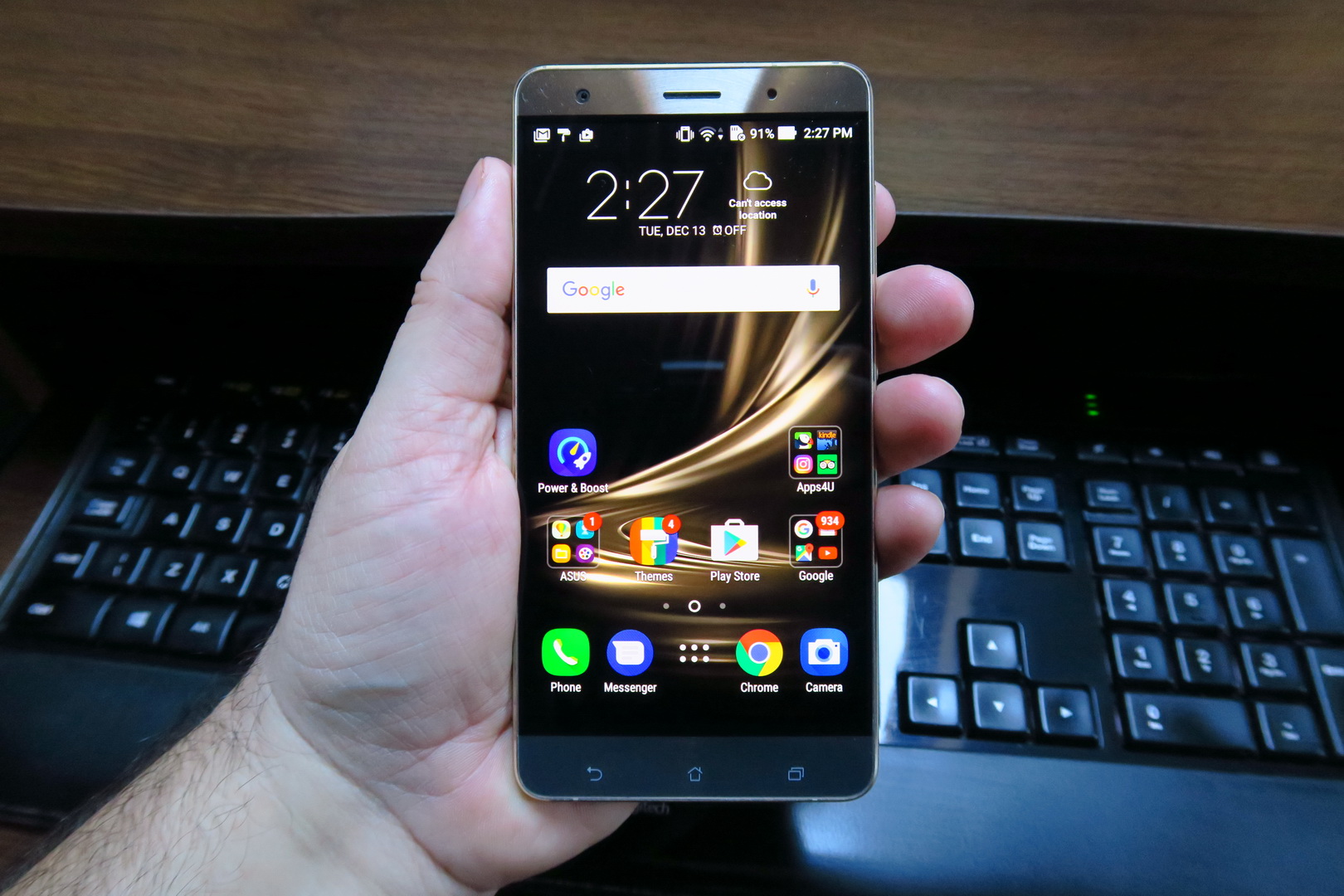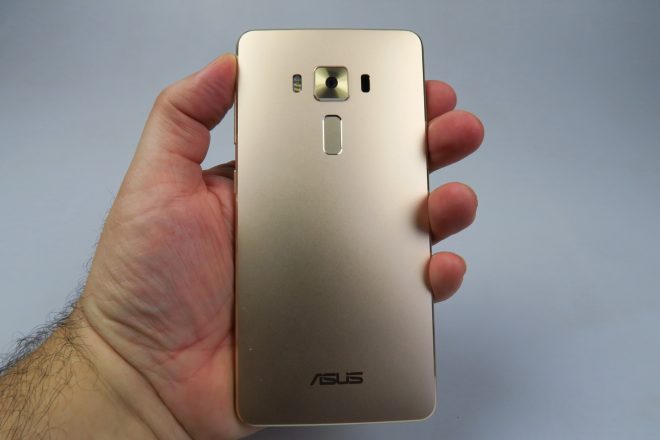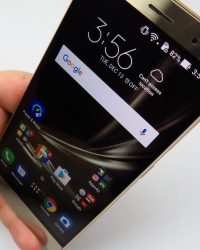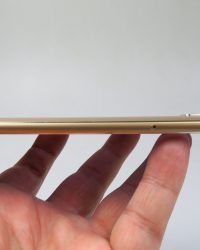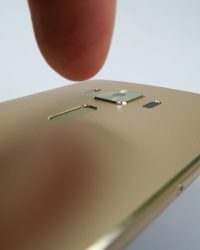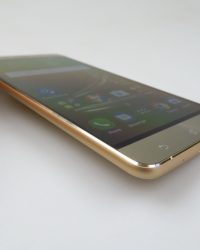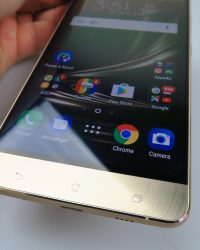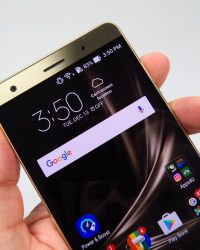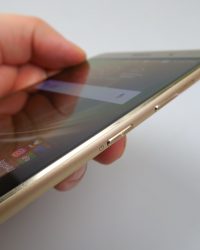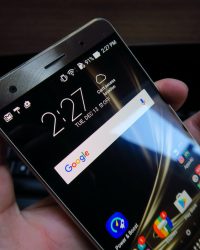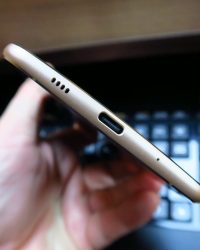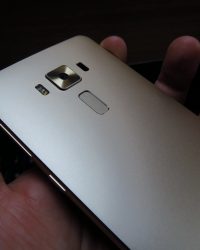After reviewing the ASUS ZenFone 3 in two versions, we thought it couldn’t get any better than this. Well, it did, as the ASUS ZenFone 3 Deluxe came, with future proof specs. We reviewed the smartphone over the following lines and we’re dealing with a premium design handset, with ultra high end specs and the allure of a gaming phone. Launched in August and priced at $800, this phone was tested by us in the ZS570KL version, with a huge 256 GB of storage.
This was the first Snapdragon 821 device we tested, but then came the Google Pixel XL to make it two. The handset has a metal chassis and it manages to be even better looking than the ZenFone 3, which was already sexy, in its own right. There are no antenna lines, which is a bit of a premiere for a metal handset. This 5.7 incher gets an aluminum chassis, with a complex 240 steps cutting process involved in its making.
The typical circular pattern of all ASUS Zen products is here, as special reflections of some portions of the facade. There’s a 1.3 mm slim bezel here and a screen to body ratio of 79%. Availability of the product comes in hues like glacier silver and sand gold, for example. Measuring between 4.2 mm and 7.5 mm in thickness, this smartphone also weighs 172 grams, both reasonable measurements for its diagonal size.
We compared it to the LG V20, which is 0.1 mm thicker and 2 grams heavier, so they’re basically the same. At least our model is slimmer and lighter than the Nexus 6P, which also had a similar format. However, the Deluxe is 3 mm shorter. It offers a perfect fit in the hand and it provides a comfy usage even with a single hand. The build is solid, there’s nice button feedback and my only gripe is the fact that capacitive buttons are placed too low.
A great design and let’s see if the screen follows suit. It’s 5.7 inch panel, with Full HD resolution, a Super AMOLED panel and a 79% screen to body ratio. There’s Gorilla Glass 4 protection in the mix and the promise of 100% NTSC colors. ASUS also included something they call Tru 2 Life technology here, on their slim bezel screen.
We also get oleophobic coating and a 3 million to 1 contrast ratio. The viewing experience involved Google Photos as the video player of choice and we noticed that the colors really pop on this Super AMOLED screen, plus the contrast is solid, brightness is high and the black is deep. View angles are also wide. Pixels have a Pentile Matrix setup and the luxmeter showed us a value of 451 LUX units, which is good, but not spread in uniform fashion all over the screen.
The value mentioned above surpassed the Huawei P9 Lite and iPhone 7 Plus, but scored below the OnePlus 2 and HTC 10. It’s also on part with the Galaxy S7. Settings involve brightness, font style and size and a screen color mode, that lets you set up color temperature via a slider. There’s also an Always On feature for the screen and you can set up the clock style and more. It’s a good display, so let’s see if the rest of the hardware is as good.
The CPU is a Qualcomm Snapdragon 821 unit, clocked at up to 2.4 GHz and we also get an Adreno 530 GPU, 6 GB of DDR4 RAM and then there’s a 5.5 inch version of the phone that only brings 4 GB of RAM, just so you know. Storage is 256 GB on our version, plus there’s a microSD card slot in the mix. Of course, with such huge specs, there’s no trace of lag and games run to perfection here. The frame rate, lighting and textures are all perfect.
Apps start instantly and we had zero problems with this phone. On the benchmark front, we got to third place in Quadrant from all the devices we tested, scoring below the Galaxy S7 Edge, while in AnTuTu 6 we were placed fourth below the iPhone 7 units. In 3DMark Ice Storm Unlimited we once again hit the third sport, with only 3k points below the iPhone 7, which is not bad.
Among the Android models, this device is podium material for sure, only major flagships beating it. Temperature wasn’t sacrificed for the sake of performance, since we achieved 34.9 degrees Celsius after running the benchmark GFXBench and 35 degrees after Riptide GP Renegade, so there’s no overheating. So, now it’s time to address the battery. We get a 3000 mAh unit here, the same capacity as the predecessor, ASUS ZenFone 2 Deluxe.
There’s also Quick Charge 3.0 and a charger with 9V/2A/18W available, able to juice up the handset to 60% in 39 minutes. We proceeded to do a HD video playback time test and reached 10 hours and 40 minutes, which is basically the equivalent of a whole season of a Netflix TV show, so that’s solid. It also beats the playback time of the LG G5 and Huawei Mate 8, but scores below the Galaxy S5 and Note 5.
In PCMark things were a bit more underwhelming, with 6 hours and 40 minutes registered, which is superior to the OnePlus 2 and ZenFone 2 Deluxe, but inferior to the Pixel XL and ZenFone 3. Charging is excellent, at 1 hour and 24 minutes, taking up the 10th spot from all the models we’ve tested. This beats the Galaxy S7 Edge and Note 5.
Settings for the battery include Modes, like Performance, Normal, Power Saving, Super Saving and Custom, which lets you tweak CPU usage, brightness and network use. Users can also switch to Super Save at a certain level, if selected, plus scan the device and suggest a battery mode. There’s also Doze and in the end aside from the continuous use, everything checks out here.
On the acoustics front, ASUS provides us with a 5 magnet speaker, with a Smart Amp, high bass and low distortion. There’s SonicMaster 3.0 technology in the mix, HiRes audio and the promise of 4 times CD quality. We didn’t get a specialized music player, so we resorted to Google Play Music. We also get the typical ASUS Audio Wizard app, an EQ software with modes like Movie, Gaming, Music, Outdoor, Smart and Vocal.
There’s also an Advanced area, with options like volume, bass, treble, dialog enhance and a 5 channel EQ. The listening experience brought us high volume, a very loud sound, that was also clear and we also registered a great bass and voice, plus high notes. When the decibelmeter kicked in, we reached 85.4 dBA with our audio sample and a gigantic 97 dBA in Riptide GP Renegade, which is huge. This would place the phone on the first spot all time, since the previous champions were at 95 dBA.
Since it’s a Deluxe model, headphones are also quite special, ZenEar Hi Res units, with great bass, voice rendering and they’re also comfy. They have the best isolation I’ve seen in action, but the volume isn’t very high. FM radio is also in the mix. With everything going so well, there are also minor drawbacks to take into account and the camera has some of them.
There’s a 23 megapixel back shooter on the ASUS ZenFone 3 Deluxe, with 1.12 micron pixels, PixelMaster 3.0 technology, laser focus technology, PDAF, continuous autofocus, 4 axis optical image stabilization, dual tone flash and F/2.0 aperture. We’ve got a 6 element lens and a Sony IMX238 sensor, while selfies are taken using an 8 MP cam with F/2.0 aperture. The camera app starts up fast, focus has great speed and zoom is fluid. Sometimes the picture taking is a bit slow, for some reason.
The camera UI is just as we left it on the ASUS ZenFone 3 models, with functions like HDR, white balance, ISO, exposure, focus settings and the Manual mode, that adds shutter, focus, white balance in the mix. As usual for a ZenFone, there’s a ton of Modes available: Auto, Manual, HDR Pro, Beautification, Super Resolution, Children, Low Light, Qr Code, Night, Depth of Field, Effect, Selfie, GIF, Panorama, Miniature, Time Rewind, Smart Remove, All Smiles, Slow Mo and Time Lapse.
Time to see if a camera with so much promise can deliver or not. We took a bunch of indoor shots first, during a special launch event and got some good details, but also some blurred shots. It seems that the cam can’t face moving objects. Colors were pretty realistic, the lighting was OK and we also got some nice closeups. Somehow, the results feel a bit inferior to the ones of the ZenFone 3, which we also took to events.
During the day time, we have a full gallery of shots here, with nice clarity, but also an artificial feel to them. The oversharpening that was widespread on Samsung models 2 or 3 years ago is totally present here and the colors feel artificial. We took nice selfies and also a pretty solid HDR shot. Thanks to the high resolution, you can zoom in all you want and the details will be great.
Lighting and clarity are quite OK and we have a great texture of cars, posters and buildings we took photos of. Everything is crisp, crystal clear, too perfect actually, that’s why sometimes it feels artificially corrected. We took a zoom test of that big hotel and the results were stunning, even at max zoom, so very good details for this cam.
Closeups take a bit more work, to get to focus properly and patience is required. Panorama is rather modest, at 9600 x 992 pixels, but it’s pretty clear. There were some dynamic range problems here and there and sometimes the background of shots was blurred. The pics remind me of the Lenovo Vibe X3, if I really had to make a comparison.
Once again, there were times when the general behaviour of the camera felt inferior to the ASUS ZenFone 3, the 5.2 inch and 5.5 inch versions. At least these sensors are clearly superior to the ones of the ASUS ZenFone 2 Deluxe, so the upgrade is clear. Low light capture brought on good clarity and lighting, reasonably sized street light halos, but also some annoying fog and blue-ish hue on the sides.
The flash felt too powerful, washing out the subjects with its light. Buildings have a nice texture, but there were shots when the usual yellow hue somehow became violet. Strange color choice here, but clearly superior to what the ZenFone 2 Deluxe achieved nocturnally. However, when compared to the iPhone 7 units and Galaxy S7, this 23 MP shooter totally pales.
Videos are shot in Full HD, MP4 format, at 30 or 60 FPS, but there’s also 4K video and slow motion. Indoors we registered a good microphone, but the image was a bit dark. The exposure was rather OK and the handset felt like the equal of the ZenFone 3. Outdoors clarity was good, but we lost some details when zooming in. The color calibration was weird and the 4K saved the day, with perfect results, in both brightness and clarity.
Some wind problems appear, so the microphone isn’t perfect, but what’s good is the exposure change that happened during filming. Clarity is perfect and we also had a nice slow motion. Stabilization got its own test and I was happy with the results. It’s clear that this device stabilizes videos better than the ZenFone 3 and there’s also no focus loss, so that’s an area where it beats the iPhone 7.
I felt that one of the videos, the one of the hotel had a bit of sun burn, so beware of strong sun during video capture. The 60 FPS clip was a bit foggy and also had a bit of detail loss. In the end the ASUS ZenFone 3 Deluxe isn’t far from the ZenFone 3, filming-wise, with better OIS on its side, though. It’s also on a level playing field with the Galaxy A models and a bit below the Pixel XL.
Low light videos were a different tale, with a serious violet hue, shaky image and an annoying fog. They take the frame rate to 12 FPS and everything is annoying, so forget about filming during night time concerts. That’s possibly the biggest drawback of this 23 MP cam. And even in spite of that, the ZenFone 2 Deluxe was worse, so at least we surpassed it.
Moving on to other things, we used Chrome as the default browser and it was fast, plus had good benchmark results. The virtual keyboard has Swype and a numeric row, while also being very comfy. On the connectivity front, this device is a big achievement, as the first metal phone without antennae cutouts made of plastic or glass windows.
It’s got a dual mic with noise reduction, FM radio, VoLTE, WiFi a/b/g/n/ac, 2X2 MIMO support and Bluetooth 4.2. Then there’s WiFi Direct, GPS, Glonass and a dual SIM setup, where the first SIM is a micro SIM and the second a nano SIM, that can also be used a microSD. Of course we also get 4G LTE Category 12, USB Type C and NFC. Calls are loud and clear, noise cancelling is perfect and then there’s Speed Dial and a ton of functions and options within the dialer, including call recording.
We also did a SpeedTest, reaching 87 Mbps in 4G downloads and 47 Mbps in uploads, while WiFi brought on an excellent 442 Mbps in download and 25 Mbps in upload. The download on WiFi was really huge and a record for a phone. On the OS, UI and apps front, we’re running Android Marshmallow with Zen UI 3.0 on top, offering the same experience as the classic ZenFone 3.
The UI is minimal, we are flooded with modes, options and functions and the multitasking is done via carousel. There’s also Pinning here and the dropdown section includes Quick Settings as bubbles and notifications too. Swiping down on the homescreen reveals what’s trending, searches and apps both. Keeping the homescreenn pressed reveals options like widgets, icon size, alignment, scroll effects, font size, con label and wallpapers, as well as icon packs.
Then there’s themes, app lock, animations and grid size. As you can see, we’ve got a ton of options and sub options to play with and you may end up spending tens of minutes customizing your experience and making your phone unique. Settings include Do Not Disturb, ASUS Cover, ZenMotion (double tap, draw, one hand more and more), plus there’s a function called OptiFlex, that speeds up the device.
Glove Mode, Game Genie (recording of gameplay and streaming to Twitch and YouTube) are also available here, as well as an Easy Mode and Kids Mode. Encryption and screenshot complete this list. The fingerprint scanner lets you answer calls, launch the camera, unlock the device is just 0.2 seconds and it scans the print at 360 degrees.
It’s got a 16 step setup, which is kind of long and it’s not exactly as fast as I hoped when it comes to unlocking the handset. The preinstalled apps list includes 51 names, which of course is a lot, but many of them can be uninstalled or removed. The list has the usual suspects, like Kindle, Facebook, Laser Ruler, Photo Collage, Mini Movie, Mobile Manager, Puffin, Quick Memo, Trip Advisor and WebStorage.
And the time of the verdict has arrived!
Here are the Pros:
- premium build
- best built ZenFone ever
- innovative antenna design
- perfect hardware
- very loud
- good display
- nice OIS
- OK indoor shots
- huge WiFi downloads
- good battery (charging and video play only)
- great performance
And the Cons:
- lots of preinstalled apps
- overall the camera feels below the ZenFone 3
- poor low light capture
- low PCMark result
- speaker is easy to cover
- Zen UI hasn’t changed in a while
While the ASUS ZenFone 2 Deluxe was a gaming phone, this one is truly a luxury device, a future proof machine that looks great and performs great. It’s the best music phone of 2016, has a bright screen, a good battery for video playback and it will handle games for at least 2 or 3 years without lag. Gamers and flagship lovers can ask for nothing better with Android till the Snapdragon 835 devices arrive and even then this model will hold its own.
The only basic drawback is some of the camera behaviour, particularly colors and low light capture. Future proof hardware at its best! The updated price is here.

